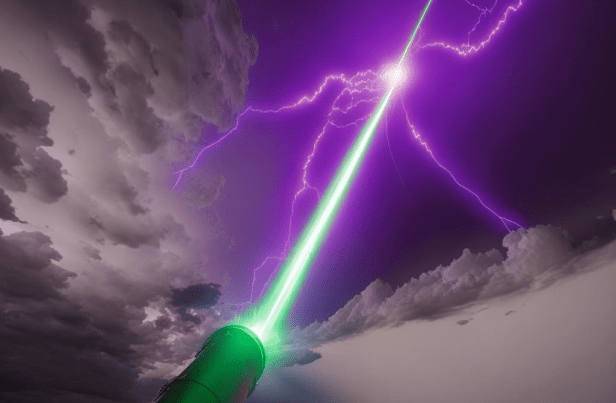
Lightning strikes have long posed serious risks to critical infrastructure worldwide. However, with the advent of laser lightning protection, scientists can now influence and control the path of lightning bolts using powerful laser pulses. This breakthrough technology offers a revolutionary way to safeguard structures by guiding lightning safely to designated grounding points, reducing random and damaging strikes during storms.
What Is Laser Lightning Protection?
Laser lightning protection involves firing extremely fast pulses of laser light into the sky during a storm. These pulses create a channel of ionized air, essentially forming a temporary, invisible “wire” in the atmosphere. This channel attracts and guides the lightning bolt, directing it toward a safe location like a lightning rod or a grounding tower.
The goal? Prevent unpredictable strikes on sensitive structures like airports, nuclear plants, and wind farms.
The Real-World Experiment That Proved It Works
One of the first successful large-scale demonstrations of this technology took place on Säntis Mountain in Switzerland. This peak is known for being one of the most lightning-struck spots in Europe. In a field test led by a European research team, a high-powered laser was installed near a communication tower.
During storm activity, the laser was fired into the sky, and several lightning bolts were observed to follow the laser-guided path rather than striking randomly. This marked the first time in history that scientists were able to manipulate lightning in real-time using laser light.
Why It Matters
Traditional lightning rods have been around for centuries. While they work well, they have limitations—they can only protect a small radius based on their height. If you want to protect a wider area, you’d need multiple rods or absurdly tall structures, which isn’t practical.
Laser lightning protection doesn’t have that limitation. It can provide instant protection across large areas, especially useful for:
-
Wind farms scattered across hills and valleys
-
Airports with multiple terminals and runways
-
Power stations and nuclear facilities
-
Rocket launch pads and military zones
In other words, anywhere that needs high-stakes protection during electrical storms.
How It Works: Breaking It Down
-
Laser Activation
During a storm, a laser emits thousands of quick pulses per second into the sky. -
Ionized Air Path Creation
These pulses heat the air, stripping electrons and creating a temporary plasma channel. -
Lightning Attraction
The plasma path becomes the easiest route for the lightning to follow, just like water flowing downhill. -
Grounding the Bolt
The system then safely redirects the strike to a grounded rod or designated safe zone.

Safety and Environmental Considerations
While the idea of firing powerful lasers into thunderstorms sounds risky, scientists have ensured that laser lightning protection systems are completely safe for humans, aircraft, and wildlife.
Unlike lasers used in weapons or industrial cutting, these beams are highly directional and designed not to interfere with aircraft flight paths. In fact, they’re automatically disabled if a plane is nearby.
Also, no harmful chemicals or pollutants are released, making this an eco-friendly alternative to other storm protection methods.
The Future of Lightning Defense
As climate change continues to increase the frequency and intensity of storms, the need for smarter, scalable protection systems is growing. Laser lightning protection could soon become a standard tool for:
-
National weather agencies
-
Military defense systems
-
Commercial aviation hubs
-
Space missions and satellite launches
Even architectural firms designing high-rise buildings are taking an interest in this technology.
For detailed research, you can explore the Nature Photonics publication that documented the Swiss laser test.
Challenges Ahead
Laser lightning protection is still in its early stages. Some hurdles that scientists and engineers are currently addressing include:
-
Cost-effectiveness: High-powered laser equipment is still expensive.
-
Mobility: Making the systems portable for use in various terrains.
-
Regulatory approval: Ensuring airspace safety and meeting international standards.
Once these challenges are overcome, the sky’s the limit—quite literally.
Frequently Asked Questions (FAQ)
Q1: Is laser lightning protection available for home use?
A1: Not yet. The technology is currently being developed for industrial and governmental infrastructure. It’s not suited for residential use due to scale and cost.
Q2: How far can a laser guide lightning?
A2: Early tests have shown effectiveness up to several hundred meters, but research is ongoing to extend the range.
Q3: Does this replace the traditional lightning rod?
A3: It can enhance or complement traditional rods, especially in environments where rods alone are insufficient.
Q4: Is laser lightning protection dangerous?
A4: No. These systems are designed with safety protocols and shut down automatically when aircraft or other risks are detected.
Q5: When will this technology be widely adopted?
A5: Likely within the next 5–10 years, as testing continues and the cost of high-powered lasers becomes more accessible.
Conclusion
The ability to guide lightning with precision might sound like something out of a science fiction movie, but it’s now a proven reality. Laser lightning protection has the potential to redefine how we defend our infrastructure from nature’s electric wrath.
As research continues and the technology matures, it’s only a matter of time before we see lasers not just in labs—but lighting up the skies to keep us safe.




